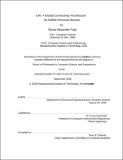UIA : a global connectivity architecture for mobile personal devices
Author(s)
Ford, Bryan, 1973-
DownloadFull printable version (3.852Mb)
Alternative title
Global connectivity architecture of mobile personal devices
Other Contributors
Massachusetts Institute of Technology. Dept. of Electrical Engineering and Computer Science.
Advisor
M. Frans Kaashoek.
Terms of use
Metadata
Show full item recordAbstract
The Internet's architecture, designed in the days of large, stationary computers tended by technically savvy and accountable administrators, fails to meet the demands of the emerging ubiquitous computing era. Nontechnical users now routinely own multiple personal devices, many of them mobile, and need to share information securely among them using interactive, delay-sensitive applications.Unmanaged Internet Architecture (UIA) is a novel, incrementally deployable network architecture for modern personal devices, which reconsiders three architectural cornerstones: naming, routing, and transport. UIA augments the Internet's global name system with a personal name system, enabling users to build personal administrative groups easily and intuitively, to establish secure bindings between his devices and with other users' devices, and to name his devices and his friends much like using a cell phone's address book. To connect personal devices reliably, even while mobile, behind NATs or firewalls, or connected via isolated ad hoc networks, UIA gives each device a persistent, location-independent identity, and builds an overlay routing service atop IP to resolve and route among these identities. Finally, to support today's interactive applications built using concurrent transactions and delay-sensitive media streams, UIA introduces a new structured stream transport abstraction, which solves the efficiency and responsiveness problems of TCP streams and the functionality limitations of UDP datagrams. Preliminary protocol designs and implementations demonstrate UIA's features and benefits. A personal naming prototype supports easy and portable group management, allowing use of personal names alongside global names in unmodified Internet applications. A prototype overlay router leverages the naming layer's social network to provide efficient ad hoc connectivity in restricted but important common-case scenarios. (cont) Simulations of more general routing protocols--one inspired by distributed hash tables, one based on recent compact routing theory--explore promising generalizations to UIA's overlay routing. A library-based prototype of UIA's structured stream transport enables incremental deployment in either OS infrastructure or applications, and demonstrates the responsiveness benefits of the new transport abstraction via dynamic prioritization of interactive web downloads. Finally, an exposition and experimental evaluation of NAT traversal techniques provides insight into routing optimizations useful in UIA and elsewhere.
Description
Thesis (Ph. D.)--Massachusetts Institute of Technology, Dept. of Electrical Engineering and Computer Science, 2008. This electronic version was submitted by the student author. The certified thesis is available in the Institute Archives and Special Collections. Includes bibliographical references (p. 193-207).
Date issued
2008Department
Massachusetts Institute of Technology. Department of Electrical Engineering and Computer SciencePublisher
Massachusetts Institute of Technology
Keywords
Electrical Engineering and Computer Science.